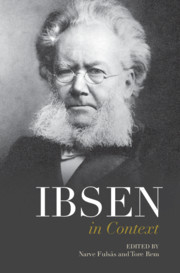Book contents
- Ibsen in Context
- Ibsen in Context
- Copyright page
- Contents
- Figures
- Contributors
- Preface
- Notes on the text
- Chronology
- Part I Life and Career
- Part II Culture and Society
- Part III Scandinavian Reception
- Part IV Internationalization
- Part V Afterlives
- Chapter 24 Biographies
- Chapter 25 Academic Responses
- Chapter 26 American Ibsens
- Chapter 27 Japanese Ibsens
- Chapter 28 Chinese Ibsens
- Chapter 29 Indian Ibsens
- Chapter 30 Mass Media and Popular Reception
- Further Reading
- Index
Chapter 27 - Japanese Ibsens
from Part V - Afterlives
Published online by Cambridge University Press: 23 April 2021
- Ibsen in Context
- Ibsen in Context
- Copyright page
- Contents
- Figures
- Contributors
- Preface
- Notes on the text
- Chronology
- Part I Life and Career
- Part II Culture and Society
- Part III Scandinavian Reception
- Part IV Internationalization
- Part V Afterlives
- Chapter 24 Biographies
- Chapter 25 Academic Responses
- Chapter 26 American Ibsens
- Chapter 27 Japanese Ibsens
- Chapter 28 Chinese Ibsens
- Chapter 29 Indian Ibsens
- Chapter 30 Mass Media and Popular Reception
- Further Reading
- Index
Summary
This chapter traces the history of the critical reception of Ibsen in Japan which started in the Meiji period (1868–1912). It discusses Ibsen’s breakthrough in the late nineteenth century, Ôgai Mori’s novelistic reinterpretation of Ibsen’s individualism through a Confucian lens, Ibsen-inspired female characters in Sôseki Natsume’s novels, and gives an overview of the development of Ibsen’s position in Japanese theatre up to the present. The chapter also takes up a variety of modern Ibsen performance with Japanese twists, from a Noh-inspired Doll’s House and a female Dr Stockman, to the ever-popular Hedda Gabler whose problematization of the ‘calculated’ marriage strikes a chord with contemporary audiences. The chapter ends with some reflections on the evolving quality of translations, from ad hoc experimental translations via English and German in the Meiji period, to the present situation in which the reader can choose among a selection of skilful translations from the original Norwegian.
Keywords
- Type
- Chapter
- Information
- Ibsen in Context , pp. 239 - 247Publisher: Cambridge University PressPrint publication year: 2021

